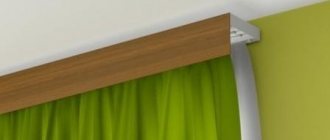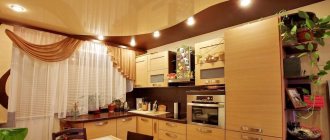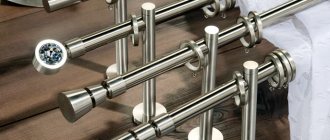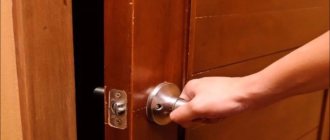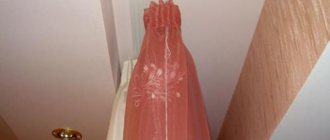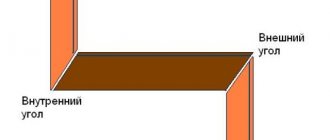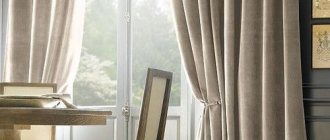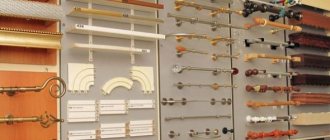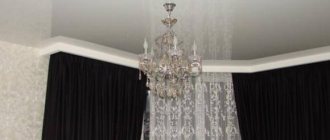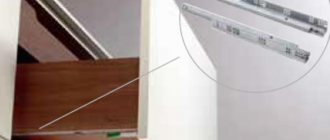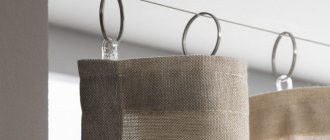17971 0 1
Icer October 22, 2016Specialization: master in the construction of plasterboard structures, finishing work and laying floor coverings. Installation of door and window units, finishing of facades, installation of electrical, plumbing and heating - I can give detailed advice on all types of work.
Today I will talk about how to install a ceiling cornice, since this type of product is one of the most popular today. We will figure out how to properly attach to various bases, and what nuances you should pay close attention to during work. After reading this review, you will be able to carry out the work yourself and achieve excellent results.
In the photo: the ceiling cornice is easy to attach and looks great
Ceiling cornice design
Before you begin work, you need to purchase a cornice; it can be sold either as a set or as individual elements, so first of all you need to figure out what parts it consists of:
This diagram shows in detail all the structural elements
| Materials | Description |
| Cornice profile | This is the main element on which the curtains are held; it can be single-row, double-row or three-row. As for color, most often it is white, but beige and brown options can be found. The manufacturing material is often plastic, but there are also aluminum products, but they are much more expensive and are not much stronger than the first option. |
| Roundings | They can be placed on the sides to give the structure greater accuracy and create a kind of frame around the window opening. They are inserted into the ends of the main profile, which is very convenient and simple |
| Straight plugs | It is used in cases where the cornice occupies the entire width of the wall. You can also use plugs if you prefer a straight cornice or there is no room for attaching curves, because they take up a certain space and increase the distance of the structure from the wall, which is not always necessary. Again, they cover the ends in curves to make them look neat |
| Connectors | They are necessary so that, if necessary, you can connect two or more main profiles. Thanks to these elements, you will not only fasten the individual parts together, but also perfectly combine them so that the curtains open and close without any obstacles |
| Stoppers | They are installed along the edges and are necessary in order to limit the movement of the hooks and prevent the curtains from crawling out of the structure. They are located on the grooves in the place you need |
| Hooks | Necessary for attaching curtains and inserted during assembly, their quantity depends on the weight of the materials that will be hung and the width of the structure, most often the elements are located in increments of 10-15 cm |
| Fasteners | Most often, the kit includes dowels, screws and plugs. From my own experience I can say that standard elements are not always suitable for use; sometimes other elements are needed |
| Decorative tape | It is needed to cover the ceiling cornice and give the structure a more attractive appearance. This element is most often purchased separately and selected depending on the interior design. If you will place the structure in a niche or a ceiling plinth will be attached in front of the cornice, then decorative tape is not needed |
Decorative ribbons can have a variety of colors and textures
When purchasing, always pay attention to the quality of the plastic; I have come across options that are made of soft material and bend very easily. So just try to bend the profile slightly, it shouldn't give way very easily.
Now let's look at such an important aspect as price, I will tell you using the example of a cornice 200 cm long, the kit usually includes the following elements:
- Double-row plastic tire;
- 4 stoppers, they are also called clamps;
- 40 curtain hooks (20 for each row);
- 2 end caps;
- Decorative baguette 50 mm wide.
The cost of such a kit starts from about 600 rubles and depends on the manufacturer and quality of the product. If you need a version with curves, then the price will be at least 200 rubles higher. The sizes available for sale most often range from 160 to 350 mm, which is quite sufficient for most window designs.
How to remove a curtain
So, how to remove a curtain that was installed earlier. The procedure is as follows:
- Stand on a stable stepladder.
- Remove the curtains. If possible, remove them along with the sliders, this will speed up the process.
- Remove the side roundings (usually they are fixed with retaining screws, which must first be unscrewed).
- Gradually unscrew the screws alternately on each side until one central screw remains.
- Slowly unscrew the central screw while holding the cornice.
The pitch of the fasteners is determined by the weight of the curtains.
However, you should not hope to securely secure curtains with heavy curtains by simply increasing the number of dowels. When choosing curtains, pay particular attention to reliability and durability. There must be some reserve. In other words, the curtain should be able to withstand a little more weight than the curtains themselves. Indeed, during operation, someone may pull the curtain with a little more force.
To make the best choice, you need to take into account the size of the room and window opening. For spacious rooms with large windows on a long wall, curtains are chosen 50-60 cm wider than the window opening. In this case, they are installed symmetrically to the window.
According to experts, the most reliable designs of ceiling curtains are attached directly to the base ceiling with anchors. And the most unreliable options are string curtains. Very often they are not able to support even the mass of curtains and sag unsightly in the middle. And in addition to aesthetic problems, this creates inconvenience in operation.
First of all, you need to think in advance about what kind of curtains you are going to decorate the window of your room with. What width is expected, what weight, how many rows will they be arranged in? Based on these parameters, you can choose the most suitable model of ceiling cornice.
Installing ceiling curtains is a serious process, but even a beginner can cope with such work. Having the necessary tools and instructions, you can install the curtains beautifully and securely.
Structure mounting options
If you have purchased a cornice, then you need to attach it efficiently and securely; this is what will be discussed in this section. I will talk about different technologies for carrying out work, and we will figure out how to reliably fix the structure on absolutely any surface.
Moreover, I decided to take an unconventional route; we will not consider base options, but will analyze which fasteners can be used in different situations.
Option No. 1 – dowel-nails
The most traditional solution for most cases, especially when it comes to city apartments. Let's figure out how to attach a ceiling cornice to the ceiling using dowels:
- This type of fastener is suitable for concrete and other bases made of dense, homogeneous material . The principle of operation is simple: the screw expands the plastic dowel, and due to this it holds very securely;
This is the principle on which this fastener works.
- The cornice is pre-assembled, after which it must be placed evenly on the surface of the ceiling in the way it will stand. Then you need to use a pencil to mark the points where you need to drill holes. The fastening step should not be more than 60 cm, the curves are fixed with separate dowels;
Usually the product comes with a diagram with tips on the working process.
- Before attaching the structure, it is necessary to drill holes of the required diameter and depth; most often, the cornice is fixed using quick-installation dowels 6x40 mm. The work is performed with a hammer drill; it is better to work with safety glasses, since when drilling the ceiling, dust and small particles get into the eyes;
To get less debris into the room when drilling, use this simple device made from a plastic bottle
- Installation is carried out with an assistant; first you need to insert the dowels into the ceiling and push them all the way so that they do not stick out on the surface. Then one person holds the cornice on the ceiling, and the second tightens the screws, you can start from the middle, and then secure the two extreme points, after which the assistant can release the structure, and you can calmly tighten all the other screws;
One person should hold while you grab the curtain rod at several points
- After all the screws are tightened, the plugs that come with the kit are placed on the holes. It is better to do this before hanging the curtains, so that nothing interferes with the elements being inserted well.
Option No. 2 - self-tapping screws
This type of fastener is ideal for those whose ceilings are made of wood and covered with fiberboard, chipboard and other similar materials. Let's figure out how to install a cornice using self-tapping screws, everything is very simple:
- First of all, the structure is assembled. Everything is easy here, because the kit always comes with instructions;
- Then you need to make markings along the line of location of the future structure, this will allow you not to be distracted during the work process and eliminate the possibility that, due to inattention, you install the cornice crookedly. The easiest way is to put a couple of marks on the ceiling from the wall side; after attaching the cornice, they will not be visible;
- Be sure to involve an assistant, as you will not be able to attach the product and hold it at the same time;
An assistant must hold the curtain rod and ensure that it is positioned according to the marks
- For fastening, wood screws with a length of 25 mm or more are used, it all depends on the characteristics of your ceiling and its strength . The fasteners are positioned evenly and carefully screwed in until the structure is completely fixed;
You can tighten the screws with a screwdriver, but this will require some effort.
Do not overdo it: if you tighten the screws too much, they can simply crush the plastic and break it. Therefore, monitor the process, and as soon as the self-tapping screw is pressed tightly against the surface, stop working.
- At the end, I advise you to check the fasteners by slightly tugging the cornice in different places; if it holds well, then you can install plugs. If there is a loose fastening somewhere, then you need to tighten it and then close the holes with plugs.
This is what the final result looks like when using self-tapping screws
Option No. 3 - liquid nails
In this section we will figure out how to glue a cornice to the ceiling. This method has one big advantage - you don’t need power tools to work, and you don’t need to make holes in the ceiling. And one big disadvantage is that to dismantle you will have to tear off the structure, and the surface of the ceiling will have to be cleaned and refinished in any case.
As for technology, the process consists of several main stages:
- First of all, we need to purchase liquid nails; one tube is enough for our work . The cost of the compositions is low; you can buy a good adhesive for about 150-200 rubles. When choosing, give preference to well-known manufacturers who have proven themselves well among buyers and specialists;
Liquid nails “Moment” set instantly and can withstand loads of up to 90 kg per square centimeter
- The work begins with preparing the surface; it must be cleaned of dust, this will improve the strength of the fastening. If the surface is too loose and crumbles, then treat it with a strengthening primer, this will make the base much more reliable;
- Next, the cornice is assembled, here everything is done as usual, with the only difference being that you can immediately insert the plugs, because in this case we don’t need holes;
- The glue is applied in a zigzag motion over the entire surface, then the cornice is pressed against the ceiling . If the length of the structure is large, then it is better to call an assistant to do the job efficiently. Some compositions need to be left on for a couple of minutes, some set quickly, so read the instructions in advance to know how to use the glue;
The main thing is to glue the structure evenly, so watch its position
- The composition usually takes about a day to harden, after which you can hang curtains on the cornice and use it without any restrictions.
In this section, you need to deal with one more aspect. I often get the question, how to hide the cornice behind the ceiling plinth?
Everything is very simple and clear here:
- If the structure will be hidden behind the baseboard, then buy a cornice without a decorative strip . In this case, it is not needed, and you can save money;
- The baseboard is most often located in the form of a protrusion, so you will have to cut the elements at an angle to get around the cornice. To do this, it is best to use a special device called a miter box, which allows you to make perfect joints of the plinth, both on the outer and inner corners;
Using a miter box you can cut the baseboard at the perfect angle
- I think you understand how to secure the ceiling plinth in front of the cornice. To do this, its plane, which is adjacent to the ceiling, is lubricated with liquid nails and pressed against the surface. The composition holds the elements perfectly and, most importantly, neat joints at the corners; the better you combine the elements, the more attractive the end result will be.
Such a neat framing of the cornice with a plinth looks just great
Option No. 4 – dowels for drywall
Let's figure out how to attach a cornice to a plasterboard ceiling. For some reason, many people think that it is impossible to ensure reliable installation with this material, but in fact there are no problems if you know the technology and use high-quality materials and components. I will talk about two types of dowels, each of which is excellent for our purposes.
The first option is a “butterfly” type dowel; this option is called so because when fastened, its protrusions diverge like the wings of a butterfly. The fastening technology in this case is as follows:
The butterfly dowel always comes complete with a self-tapping screw.
- First of all, the cornice is assembled, after which it is applied to the place of future installation, and the places for attaching the structure are marked. Just outline the holes with a pencil, after which the cornice can be put aside for a while;
- Next, holes with a diameter of 10 mm are drilled. Drywall is easy to process, so you don’t need a drill or hammer drill; you can easily get by with a simple screwdriver with a drill of the diameter we need. During work, a lot of debris is generated, so it is better to cover the floor with film or something else;
- After the holes are ready, you need to insert the dowels into them; to do this, simply squeeze their protrusions so that they fit into the hole and push the elements until they stop. All that remains outside is a plastic cap with a hole;
- The cornice is placed against the ceiling, after which you can begin to attach it. To do this, you insert a screw into the hole and begin to tighten it; as you screw it in, it goes into the hole on the end of the dowel, and then tightens the element using the thread . The work is carried out until the protrusions on the back side of the drywall rest against the surface and fix our cornice.
This is what all the stages of fastening with this type of dowels look like:
The second type of fastener is “Driva” type dowels, you can see what they look like below, and even lower I’ll tell you how to properly fasten a cornice using them:
Another good mounting option
- First of all, it should be noted that products can be made of plastic or metal. In turn, plastic options are divided into dowels with a drill tip and products without it. In metal ones there is always a drill, and this option is much preferable, since you do not need to drill holes;
- To attach a cornice to drywall, you first need to assemble it and mark the fixation points on the ceiling;
- Then take the dowels and simply screw them into the desired points using a screwdriver. There is a cross-shaped cutout at the top end, into which it is very convenient to insert a screwdriver and tighten the element;
The dowel is simply screwed into the drywall with a screwdriver
- After all the dowels are installed in their place, you can begin to fasten the cornice; for this, one person holds it on the surface, and the second screws the screws into the prepared holes. As a result, the cornice holds firmly and reliably.
The technology is simple but very effective
Option No. 5 – brackets
If there is no way to fix the structure on the ceiling, then you will have to find a different way out of the situation. Let's figure out how to attach a ceiling cornice to the wall; this option is noticeably different from all those described above:
This is how do-it-yourself fastening work is carried out
- First you need to purchase a set of brackets, usually two pieces are enough for a cornice up to 240 cm wide, but if the structure is wider, then you need more fasteners;
The kit includes a bracket, bracket and screws for fastening it
- Then the brackets need to be attached to the cornice from its upper side. First, you should determine the position of the brackets, after which they are screwed with a screwdriver, since it is quite difficult to screw them into plastic with a screwdriver;
The staples are arranged symmetrically
- The brackets are inserted into the attached rails, after which you need to take the cornice, determine its correct position and mark the drilling locations. If you don’t know at what distance from the ceiling to hang the cornice, then first place it in different positions and find the best option. At the same time, do not forget that the structure must be located at least 10 cm above the upper edge of the opening window sashes so that the curtains do not create interference;
- The holes are drilled according to the size of the dowels you use. For work it is best to use a hammer drill. If the walls are wooden, then you don’t need to drill anything, you can simply screw the screws into the required places;
When drilling, try to keep the hammer drill perpendicular to the wall
- The brackets are fixed to the wall using dowels or self-tapping screws, they must be located at the same level, do not forget to check this aspect when drilling;
- Once the elements are securely fixed, you can begin installing the cornice. It is simply put on the holders and set in the desired position. The advantage of this option is that you can change the distance from the wall by moving the cornice along the bracket, this allows you to choose the optimal position of the structure.
At what height from the ceiling should I hang a cornice? I believe that the higher the structure is located, the better it looks
Varieties
The ceiling cornice (a photo of one of the options is presented below) can be made of different materials. Most often they are made from plastic, wood or metal. The choice depends on what material the curtains will be made from. There are curtain rods for light, medium or heavy fabric.
If chintz or tulle are used as curtains, a string cornice will be quite sufficient. This is a lightweight, practical type of construction. Steel or wooden types of curtain rods are used for heavy fabrics. For medium-weight curtains, a plastic curtain rod is suitable.
The design of the cornice may vary. There are products that have one, two or three rows. If you only need to hang thin tulle, a curtain rod with one rail is sufficient. If the window is breaded and covered with curtains, you need to purchase a design with two panels. Three-strip cornices are designed for use in a lambrequin ensemble.
Structures can be rigid or flexible. The second option is typical for plastic, polyurethane curtain rods. They allow you to give the strip the desired configuration. This is especially important if you are installing a ceiling cornice for a bay window, attic or figured windows. It is worth noting that flexible bay windows include more fasteners in their design. This allows you to fix bends.
Conclusion
We figured out how to hang a cornice on different bases using different fastening options. You need to choose the best option and carry out the work without outside help. The video in this article will help you understand the topic even better, and if you have questions, be sure to write them in the comments under this review.
Did you like the article? Subscribe to our Yandex.Zen channel
October 22, 2016
Ceilings, Ceiling structures
If you want to express gratitude, add a clarification or objection, or ask the author something, add a comment or say thank you!
Installation to a suspended ceiling
Installation of a ceiling cornice on a suspended ceiling can be done in an open or closed way. In both cases, you will need to use a special wooden beam. It will need to be installed before the canvas is stretched.
First, markings must be made on the prepared ceiling base. Using a level, draw a straight line. Using the markings, drill holes for attaching the ceiling beam. This procedure must be done before the baguettes for mounting the canvas are mounted.
After drilling the holes, you need to install the strips. The suspended ceiling will subsequently be attached to them. Next you need to insert the dowels into the drilled holes. A beam is attached to the ceiling surface. It is fixed with dowels. The surface of the beam should come close to the suspended ceiling (located at a distance of 1-2 mm from the canvas). You can adjust the position of the beam using mounting wedges.
Next, you can mount the tension fabric. To strengthen the material in the places where the cornice is fixed, you need to install special polymer rings. Their internal space is simply burned out. After this, you can use self-tapping screws to attach the cornice to the wooden beam. At this point, the installation of the ceiling cornice on the suspended ceiling using the open method is completed.
Using Brackets
It happens that it is not possible to mount the cornice on the ceiling. For example, the house already has a suspended ceiling, the integrity of which, of course, cannot be violated. In this case, the ceiling cornice is installed on the wall. For this purpose, special brackets are used.
Such fasteners are purchased separately in a specialized store. If the length of the cornice is up to 240 cm, you can purchase only two brackets. If this figure is higher, you need to add another bracket. Each similar element for installing a cornice has a bracket, a bracket and screws.
Next, perform simple steps. The bracket must be screwed to the top surface of the cornice. To install the ceiling cornice correctly, the plates are placed symmetrically on the surface of the profile. They are screwed on with self-tapping screws. After this, the brackets can be installed into the installed brackets.
After this, the structure is brought to the ceiling. The desired position of the cornice is determined. Markings are made in appropriate places. You can attach the cornice higher or lower. This will allow you to determine the correct position of the structure. It is worth remembering that it should be located at least 10 cm higher than the window sashes.
Completing the installation of brackets
To install the ceiling cornice on the wall, you need to drill holes in the designated places for installing self-tapping screws. If the walls are wooden, you can immediately screw the hardware into the brackets.
The structure must be level. Its position must be controlled using a building level. The brackets in this case will be located at the same level. The cornice is simply put on the mounted structure. It can be moved further from the base of the wall or moved closer to it.
It is worth considering that many experts note this feature. The higher the ceiling cornice installed on the wall, the better.
Installation on drywall
Some inexperienced craftsmen claim that it is impossible to mount a ceiling cornice on drywall. This is far from true. First you need to purchase everything you need for installation. Dowels of the appropriate shape (“butterfly”) must be at hand.
The cornice must be assembled and attached to the base of the ceiling. The holes are simply outlined with a pencil. Next, the cornice is put aside. Using a conventional screwdriver, holes are drilled in the material. They should be 10 mm in diameter. Dowels are installed in the holes. To do this, their protrusions are compressed. Each such element must be pushed into the hole until it stops.
Then the cornice must be attached to the ceiling. You need to insert a screw into the hole in the cornice. It hits the tip directly into the plastic hole. It goes into the limit switch, tightening this element of the retainer with a thread. The protrusions on the back side of the material should rest against the surface. This is how the cornice is fixed. It will adhere firmly to the surface of the drywall for a long time. However, in this case it is better to use medium or light weight fabrics.
Having examined step by step how the installation of a ceiling cornice is carried out, everyone will be able to complete the installation themselves. In this case, a number of nuances are taken into account. By correctly performing the installation work, you can create a durable structure that will be used for a long time.
